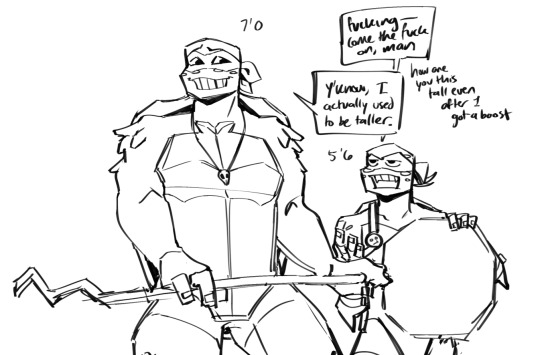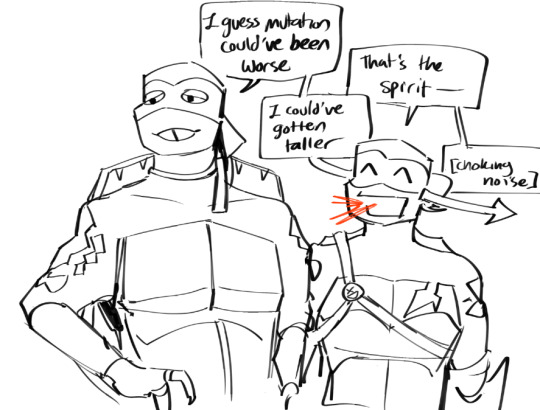#quaternion-group
Explore tagged Tumblr posts
Text
to this day i still think it’s so heartbreaking that so(3) is not commutative
#is there a commutative way to describe 3d rotations#smells like the answer should involve quaternions but i’m not sure#if you’re confused look up ‘3d rotation group’ on wikipedia
29 notes
·
View notes
Text
What you want are non communitive number systems!
Off the top of my head, you can create number systems based on "actions" and have each number be a type of thing you can do (like, say, a series of turns on a rubiks cube) and multiplication gives you another action, which is just, do one thing then the other.
You can imagine that, even with the rubix cube example, a•b ("doing" a move b then "doing" a move a) isnt necessarily the same as b•a ("doing" a move a then "doing", a move b) and there might be reasons you would want to lable some of thease numbers as 1 or 2.
i know the "move" of not doing a move at all usually is called 1, because you get a nice thing where a•1=a, or "doing nothing, then doing something" is the same as "just doing the thing", and similarly 1•a=a
...in this case, no matter what you pick to call 2, 1•2=2=2•1, but you can imagine some reasonable choice of 1 and 2 exists where that doesnt work.
Quaternions are a famous one, where each number corresponds to a rotation and scaling in 3d space.
(its actually like. a 4d object n stuff but it doesn't really matter, i. dont know any great resources for this, wikipedia might be okay? but you can probably keyword "quaternions" and get somewhere)
Its an extension of the complex numbers, where each number is a rotation and scaling in 2d space!
(think about why i might have not been able to use the complex numbers as a non communitive number system, just based off the rotations thing)
And theres just lots of ways besides this im sure. Groups are what we call number systems that are not necessarily communitive, but are necessary associative (a(bc)=(ab)c) if you want to learn more.
Okay math side of Tumblr I need help
So I was reading Broca's Brain by Carl Sagan yesterday, and there's this point where Sagan lists off a few bizarre scientific facts as examples of how true science is often more interesting and whimsical than anything a hack pseudoscientist could make up.
One of these facts was that there's a logically sound arithmetic in which 2 times 1 is not equal to 1 times 2. This piqued my interest, so I took to Firefox and Wikipedia to figure out more, but I searched up a few things and couldn't find anything helpful.
So does anyone here know what he's talking about and how that works?
#mathblr#sorry for the long reply... you activated one of my trap cards (displaying curiosity about math)#groups#communitivity#quaternions#rubix cube#rotations#addition
12 notes
·
View notes
Text
Once we were one of the largest families — today, we can be counted on the fingers of one hand.
Death has become closer to us than our own breath.
Help us… life has become unbearably hard
https://gofund.me/a9850e65
@andvaka @autisticats @mens-rights-activia @5sos @teaboot @teeentyonepilots @ilhoonftw @prinnay @podcastwizard @pantaloonwarrior @gentlesleaze @heyitsphoenixx @h @hangulteam @chilewithcarnage @onebadnoodle @of-aurora @onyxstorms @slutdge @wolstinien @wadewilsonparker @quaternion-group @tyleroakley @kikmessenger @kirukrono @littlegirlinvisible @of-aurora @cobane @beebeedibapbeediboop @ultimatecryptid @taylorswift @xenodile @xxang3l-trapxx @sayruq @xxang3l-trapxx @froginakettle @fallingtowers @fullofworm @fricklefracklefloof @fridgebride @frie-nds
#free palestine#fypage#free gaza#deadpool and wolverine#epic the musical#gaza#viral#hugh jackson#bill cipher#formula 1
9 notes
·
View notes
Text
j's most extreme culinary challenge @quaternion-group
16 notes
·
View notes
Text
semi-daily math post since people asked—
you may have heard about historical arguments in mathematics— irrational numbers, imaginary numbers, even quaternions— but one of the more modern divides is over something called the axiom of choice. an axiom is one of the base assumptions of a system of logic— things that we presume to be true so that we can rely on their logic to create new conclusions. our common system of logic is called zermelo-fraenkel set theory. (if you choose to accept the axiom of choice, it’s abbreviated ZFC to include that.) set theory is extremely foundational and has to do with how we group collections of abstract mathematical objects; one axiom in ZFC, for example, is ‘if we have two sets, there exists a union of the sets.’ for example, the union of {x,y} and {y,z} is {x,y,z}.
the axiom of choice essentially states that given an infinite collection of sets, you can make a new set by choosing one element from each of those sets. kinda abstract. kinda not as abstract as you’d think, too? but once you start thinking about choosing from infinite sets without a ‘rule’ to follow— infinite arbitrary choices— it can get dicey. it was originally controversial because some of its conclusions were kind of counterintuitive; for example, the banach-tarski paradox, which lets you divide an ideal sphere (so, infinitely divisible) into complex parts such that you can manipulate those parts into two identical spheres of the same volume as the original. there’s even a common math joke about it by jerry bona— “the axiom of choice is obviously true, the well-ordering principle obviously false, and who can tell about zorn’s lemma?” poking fun at the fact that… those three things are all equivalent to the same thing, the axiom of choice, just presented in different ways that make them seem either very intuitive or very counterintuitive!
these days the axiom of choice is widely used. i wouldn’t say ‘widely accepted,’ exactly, because axioms aren’t exactly ‘true’ or ‘false’; they’re a basis of logic we either decide to use or decide not to use based on whether it’s useful for us. (people study other systems of logic too! look up peano arithmetic). that being said, apparently it’s useful enough to have justified its existence to most mathematicians :-)
43 notes
·
View notes
Text
my friends made turtles with me. say hi to Tetsu (first one with the stop sign, belongs to @quaternion-group) and Bietris (second one, belongs to @keeperesque)
they are also humans-turned-turtles and both of them are absolutely fucking lying about having gotten shorter it's just a running bit they commit against Frisbee cuz she's so excited about gaining 4 inches of height post-mutation



19 notes
·
View notes
Text
It’s 8 Mar 2025. I just flipped my part back to the left side, where it was before I focused on it. Now I wish I could shift focus out of my lower right leg. That’s very difficult. The cat does it without thinking about it. I know how the process generally works but I realize I should try to list out steps, if only to see how pieces fit.
One way is to involve focus elsewhere. The obvious problem with that is focus only lasts as long as it does, and what is being ignored often comes back worse. This can be physical or mental, tObject or iObject. The other obvious is to build the potential so there are more permutations, so the gsProcess can effectively deactivate the pain signals by isolating them, meaning by defining them in the Is and Not process, and through the mechanisms described.
Example is the gsRectangular form develops together with the fD form, where fD of course refers to the diamond but the notation is used way too often to be formally gsDiamond, at least for me now. That identifies to a Bip which is then within a Bip field which then effectively defines identity. Isolation of identity is extinguishing, so this is the same process as condemnation because that removes the Thing of the negative you from visibilty. I said negative you because one process we’ve discussed is the elimination of the negatives which you shed. It’s interesting how that concept, which came to me in desperation because the negatives in my life then were overpowering, which now reads as having been necessary, has become fundamental. It’s fundamental to the generation of gs in D-structure.
How does that work? Generalizes to poles and IC, etc. as you know. Ok. Remember that gs radiate from the Ends. Right, so each Attachment along an Extent imposes an End on that threading, which generalizes to the count along szK, which both localizes and generalizes to the Registry of Actualities, which is the name for the conception of the reals, meaning real numbers and real number spaces as they generate out of the higher dimensional mathematics represented by complex numbers, by quaternions, etc.
I love, btw, how when you set the real to 0, you get countings of complexity because 0 is not a simple thing, but rather the summary state of all threads which can 0. Or maybe it’s 0 because there’s 1 counterexample. Same idea.
I’m suddenly seeing Galois. The idea is that we look at how something is composed, which you can list out for the various powers of a polynomial, with the idea being that it takes pieces and makes them into a whole, and thus if that’s solvable into whole pieces, then you have a solvable group, and I’m finally, after a holy amount of work, can see that translate into solvable with radicals, with the effective limit for generality being 4th. We explain this using gsProcess.
Understanding Galois has been my top level goal for years. I am stunned this is happening.
I just realized I keep hitting the function key instead of the shift. Annoying habit developed that I can identify and control or eliminate. Powerful idea that identity calculation. It maps directly into ideas of theta vectors and angles through and across probability distributions, which I’m also seeing map. Very cool.
This follows something important to me but which I’ve been unable to get out, which is that some weeks ago I started to see an ambiguous face of you in light. That has increased in intensity and frequency as Storyline has developed. That’s about all I can get out about that.
0 notes
Text
IEEE Transactions on Fuzzy Systems, Volume 33, Issue 2, February 2025
1) Distributed Saturation-Tolerant Fuzzy Control for Constrained Stochastic Multiagent Systems With Resilient Quantitative Behaviors
Author(s): Xiaohui Yue, Huaguang Zhang, Jiayue Sun, Lulu Zhang
Pages: 514 - 523
2) Bayesian Weighting for Multiple Criteria Group Decision-Making With Interval Preference Information
Author(s): Fan Liu, Huchang Liao
Pages: 524 - 536
3) Adaptive Integral Sliding-Mode Control for a Class of Nonlinear Spacecraft Proximity Systems Under Multi-Source Disturbances and Unmodeled Dynamics
Author(s): Yuan Zhu, Xin Ning, Zheng Wang, Caisheng Wei, Shichao Ma, Likuan Qiu, Shiyu Wang, Yunfei Bai
Pages: 537 - 548
4) Hierarchical Fuzzy Model-Agnostic Explanation: Framework, Algorithms, and Interface for XAI
Author(s): Faliang Yin, Hak-Keung Lam, David Watson
Pages: 549 - 558
5) Fixed-Time Event-Triggered Impulsive Secure Synchronization of Quaternion-Valued Fuzzy Neural Networks Subject to Stochastic Cyber-Attacks
Author(s): Lirong Liu, Haibo Bao, Jinde Cao
Pages: 559 - 569
6) Adaptive Fuzzy Control for Stochastic Nonlinear Systems With Delayed Input and Delayed State via Improved Lyapunov–Krasovskii Function
Author(s): Yanru Peng, Shengyuan Xu, Ju H. Park
Pages: 570 - 579
7) Reinforcing TSK Model Interpolation With Rule Weight Adjustment via Location View Analysis
Author(s): Changhong Jiang, Changjing Shang, Qiang Shen
Pages: 580 - 592
8) Parameter-Optimization-Based Adaptive Fault-Tolerant Control for a Quadrotor UAV Using Fuzzy Disturbance Observers
Author(s): Yong Ren, Yaobin Sun, Zhijie Liu, Hak-Keung Lam
Pages: 593 - 605
9) A Terminal Constraint Set-Dependent Mixed Time/Event-Triggered Approach to Multistep Fuzzy MPC
Author(s): Fan Wei, Xiongbo Wan, Chuan-Ke Zhang, Leimin Wang
Pages: 606 - 620
10) Fuzzy-Based Antiswing Control for Variable-Length Cable-Suspended Aerial Transportation Systems Considering the Hook Effect
Author(s): Hai Yu, Yi Chai, Zhichao Yang, Jianda Han, Yongchun Fang, Xiao Liang
Pages: 621 - 630
11) A Brain-Inspired Harmonized Learning With Concurrent Arbitration for Enhancing Motion Planning in Fuzzy Environments
Author(s): Tianyuan Jia, Chaoqiong Fan, Qing Li, Ziyu Li, Li Yao, Xia Wu
Pages: 631 - 643
12) From Fuzzy Rule-Based Models to Granular Models
Author(s): Ye Cui, Hanyu E, Witold Pedrycz, Zhiwu Li, Xianmin Wang
Pages: 644 - 656
13) Adaptive Fuzzy Distributed Optimal FTC for Nonlinear Multiagent Systems Based Multiplayer Differential Game
Author(s): Wei Wu, Shaocheng Tong
Pages: 657 - 668
14) Scalable Feature Subset Selection With Fuzzy Rough Sets and Fuzzy Min–Max Neural Network in Hybrid Decision System
Author(s): Anil Kumar, P. S. V. S Sai Prasad
Pages: 669 - 679
15) Minimum Adjustment Consensus Optimization Models With Fuzzy Preference Relations: The Perspective of Cardinal and Ordinal Consensus
Author(s): Zhengmin Liu, Wenxin Wang, Ruxue Ding, Peide Liu
Pages: 680 - 693
16) A Novel Composite Observer Based Approach for Dynamic Event-Triggered Adaptive Fuzzy Control of Nonlinear Systems Under DoS Attacks
Author(s): Xinjun Wang, Shenghang Liu, Ben Niu, Xinmin Song, Huanqing Wang, Xudong Zhao
Pages: 694 - 703
17) Observer-Based Optimal Fuzzy Control for Networked IT-2 Fuzzy Systems Against Hybrid Cyber-Attacks
Author(s): Yang Li, Ju H. Park, Yang Gu, Yong He
Pages: 704 - 716
18) Generalized Fuzzy Transform and Nonlocal Laplace Operator
Author(s): Hana Zámečníková, Simone Cammarasana, Irina Perfilieva, Giuseppe Patané
Pages: 717 - 729
19) Dual Anchor Graph Fuzzy Clustering for Multiview Data
Author(s): Wei Zhang, Xiuyu Huang, Andong Li, Te Zhang, Weiping Ding, Zhaohong Deng, Shitong Wang
Pages: 730 - 744
20) Fuzzy Secure Formation Control for NMASs: A Prescribed Performance Scaling Framework
Author(s): Dianbiao Dong, Jiahe Huo, Tao Xu, Dengxiu Yu, Zhen Wang
Pages: 745 - 756
21) A ZNN-Based Solver With Adaptive Input Range Fuzzy Logic System for Time-Varying Algebraic Riccati Equation
Author(s): Lin Xiao, Dan Wang, Qiuyue Zuo, Xiangru Yan, Hang Cai
Pages: 757 - 766
22) Fuzzy Min-Cut With Soft Balancing Effects
Author(s): Huimin Chen, Runxin Zhang, Rong Wang, Feiping Nie
Pages: 767 - 778
23) Distributed Fuzzy Formation Control for Nonlinear Multiagent Systems Under Communication Delays and Switching Topology
Author(s): Haodong Zhou, Yi Zuo, Shaocheng Tong
Pages: 779 - 788
24) Observer-Based Predefined-Time Adaptive Fuzzy Prescribed Performance Tracking Control for a QUAV
Author(s): Guozeng Cui, Guanchao Zhu, Juping Gu, Qian Ma, Shengyuan Xu
Pages: 789 - 798
25) Disturbance Observer-Based Boundary Adaptive Event-Triggered Consensus Control of Multiple Flexible Manipulators
Author(s): Wei Zhao, Xiangqian Yao, Yu Liu
Pages: 799 - 809
0 notes
Text
I disagree; numbers have to be elements of sets with, um, a certain kind of algebraic structure, the exact qualifying details of which I don't have laid out.
Examples of structures, listed by the "numberiness" of their elements:
Most numbery structures: the naturals, the reals, the integers
Complex numbers, quaternions, split complexes, etcetera
ordinals, surreals
combinatorial game values, I guess nimbers
Least numbery things you could still argue are numbers: many other groups, fields, rings...
Non-numbers: Polyhedra, Well-Formed Formulae, graphs, combinatorial games [as opposed to their values]
I'm a maximal inclusivist when it comes to what I consider to be a number. if you can do math with it it's a number. it only makes sense to call something a non-number in math if you're distinguishing between two types of mathematical object and one of them doesn't have a good name besides "number".
915 notes
·
View notes
Text
The Ultimate Guide to Becoming a Successful Unity Game Developer
Unity is one of the most popular game development platforms in the world, known for its versatility and powerful features. As a Unity Game Developer, you have the potential to create stunning and engaging games that captivate audiences. However, achieving success in this competitive field requires a strategic approach and mastery of various skills. This ultimate guide will walk you through the essential steps to becoming a successful Unity game developer.
1. Master the Fundamentals of C# Programming
Unity uses C# as its primary scripting language. Mastering C# is crucial for developing efficient and effective game scripts.
Steps to Master C#:
Learn the Basics: Start with the fundamentals of C# programming, including syntax, variables, loops, and conditionals.
Object-Oriented Programming: Understand core concepts such as classes, inheritance, polymorphism, and encapsulation.
Debugging: Develop strong debugging skills to identify and fix issues quickly.
Practice: Regularly write and test small scripts to build your confidence and proficiency.
2. Understand the Unity Interface and Tools
Familiarity with the Unity interface and its tools is essential for streamlining your development process.
Key Areas to Focus On:
Editor Layout: Get comfortable with the Unity editor layout, including the Scene, Game, Hierarchy, and Project windows.
Game Objects and Components: Learn how to create and manipulate Game Objects and attach components to them.
Asset Management: Understand how to import, organize, and manage assets like textures, audio files, and animations.
3. Develop Strong 3D Modeling and Animation Skills
While collaboration with artists is common, having a basic understanding of 3D modeling and animation will enhance your ability to create and integrate assets.
Steps to Develop These Skills:
Learn Basic Modeling: Use tools like Blender or Maya to create simple 3D models.
Understand Animation: Learn the basics of rigging and animating models.
Integrate Assets: Practice importing and integrating 3D assets into Unity projects.
4. Gain Proficiency in Physics and Mathematics
A solid understanding of physics and mathematics is crucial for creating realistic game mechanics and interactions.
Key Concepts to Master:
Physics Engine: Learn how to use Unity’s physics engine to apply forces, handle collisions, and simulate gravity.
Mathematical Foundations: Master vectors, matrices, and quaternions to manage movement, rotation, and scaling.
Simulate Mechanics: Implement real-world mechanics like projectile motion and kinematics in your games.
5. Design Intuitive and Engaging User Interfaces (UI)
A well-designed user interface enhances the user experience and makes your game more enjoyable.
Key Elements of UI Design:
UI Components: Use Unity’s UI components such as buttons, sliders, and text effectively.
Layout and Design: Apply principles of good UI design, including layout, color theory, and typography.
User Experience: Focus on creating a seamless and engaging user experience.
6. Optimize Performance
Optimization ensures your game runs smoothly across different devices, providing a better experience for players.
Optimization Techniques:
Reduce Draw Calls: Minimize the number of draw calls to improve rendering performance.
Optimize Assets: Use efficient textures, models, and animations to reduce memory usage.
Profiling Tools: Utilize Unity’s profiling tools to identify and address performance bottlenecks.
7. Stay Updated with Industry Trends
The gaming industry is constantly evolving, and staying updated with the latest trends and technologies is essential for success.
Ways to Stay Updated:
Follow Industry News: Keep up with the latest news and updates in game development.
Join Communities: Participate in forums and communities like Unity’s own forums, Reddit, and Discord groups.
Continuous Learning: Take online courses, attend workshops, and read articles to continuously improve your skills.
8. Build a Portfolio
A strong portfolio showcases your skills and projects, making it easier to attract potential employers or clients.
Tips for Building a Portfolio:
Diverse Projects: Include a variety of projects that demonstrate different skills and techniques.
Quality Over Quantity: Focus on showcasing a few high-quality projects rather than numerous mediocre ones.
Documentation: Provide detailed descriptions, screenshots, and videos of your projects.
0 notes
Text
Matthew 27:27-31 (Part 1 of 4)
Matthew 27:27-31 Jesus is beaten and mocked (Part 1 of 4). “Gathered the whole garrison around Him.” They only needed a regular group of four soldiers – called a quaternion – to carry out the execution. Yet they “gathered the whole garrison around Him.” It wasn’t to prevent His escape. It wasn’t to prevent a hostile crowd from rescuing Him. It wasn’t to keep the disciples away. “Take heed of…

View On WordPress
0 notes
Text
Today is the birthday of my beloved niece, Marmar, who has turned four years old. Little Marmar, who always fills our hearts with joy, was eagerly waiting to wear her new dress and cut her favorite birthday cake. However, this time, due to difficult circumstances and rising prices, we couldn’t celebrate as she deserves.
The cost of cakes has surged to more than ten times its usual price, and even the simplest things like dresses and gifts have become out of reach. Yet, little Marmar still dreams of a birthday cake, a new dress, and a gift to make her happy on her special day.

If you care about Marmar and have a place for humanity in your heart, we ask for your help in raising funds to send Marmar a birthday cake, a new dress, and a simple gift to bring a smile to her innocent face. Every contribution, no matter how small, will make a big difference in Marmar’s life on this special day.
Thank you from the bottom of our hearts for your support and kind hearts. Let’s make Marmar’s birthday an unforgettable memory.
https://gofund.me/c3e162db
@fricklefracklefloof @ramshackledtrickster @gasterofficial @pompeii-for-elephants @ponpasta @pomeg-glitch @atlas-of-galaxies @mxwhore @mstormcloud @saintlauhrent @saiwestfield @saintence @samwinchesterblog @sam-the-panda-hero @samwinchesterappreciation
@andvakandi @autisticats @quaternion-group @queenofglitch @electricbluebutterflies @entraptasboobwindow @wadewilsonparker @vialism @memelovingbot @lilliesthings @prinnay @catbushandludicrous @chilewithcarnage @daxdraggon @slutdge @xenodile @xeneric-shrooms @xxang3l-trapxx @froginakettle @fallingtowers @fallingtowers @felix-the-snow-cheetah @sumikatt @ponpasta @turtletoria @unfunnynascarfan @ultimatecryptid @vampyretaemin @zombeesknees @ziilosdiidu @zukoromantic @fierycavalier @pkbunny @jadedisaster
23 notes
·
View notes
Text
an office surprise @namielles @quaternion-group
11 notes
·
View notes
Text
It’s now 25 Jan 2024, and I’m still not entirely comfortable with this keyboard, but it is getting better. I find it goes better if I rest my left elbow and keep the right suspended. This keeps the right from getting lazy and not reaching the arm to the keys. With the keyboard tilted the right, the left’s motion is easier. I wonder how many variations this will permute through.
I can now get into some really tight folds and can squat nicely below parallel again.
This was not what I had in mind when I started typing. Caught one: easy to tilt to the right, and that lowers my elbow an inch or two, and that makes the move toward the upper right, which is the delete key, easier. But that’s a lazy position because it makes that one move easier and the others worse. The promise of an undeveloped land versus the reality of the paths it took.
I’m in some scary stuff. Do our paths ever coincide? I have no idea what because I can’t impose a version as though I define how reality occurs. I saw these VR images and they show something interesting, which is the genericization of your image so it fits a blunt sexual fantasy, meaning it is not you but a generated image of viewpoints or perspectives, those multiple takes which are pairs, which all synthesize to very straightforward Attachment of a structure that says looks like this person to any sexual role. Like the I Dream of Jeanie concept in which the issue is the complexity of the story versus the cartoon quality of the fantasy, with that solved through this process, which is Recombinance, because that is how the elements recombine, which is where the associative comes in, meaning this provides a solution to the ‘what fits between you and the mirror’, meaning that if we take you and the mirror then what fits between is the construction which is the solution which fits. That’s how you build toward and away from ideals.
That is, because the structure is within a structure, the old container idea often used in portable or modular programming, so the structure itself is composed or constructed. I keep saying the same thing in slightly different words. Keep right elbow out or the delete key squeaks.
I was looking at Dedekind groups, which led to the quaternion group, which led to the cycle graph, which led to the understanding that this maps to IC and Triangular over gs. It also maps to the Irreducible, which in the elements of the Q8 group are represented as -1 and 1. That answers a minor technical issue I had with the idea, which is why they represent the identity element as they do, typically I see as an e with a bar over it to indicate that it’s the commuter because if you square the other terms, meaning i, j and k, then you get that e bar, which is -1. To be blunt, that means you can switch at -1. This is an elementary example of pairing, isn’t it?
I really and truly forget that I have no idea what happens next in my head. I had no idea this was coming, but it is of course the exact answer needed and the answer which fits to the count of 2 perspective. Don’t have a name for that counting not of 0 to 1 but of 1 to 2, and thus from 2 to 1 rather than 1 to 0. That basic counting shift literally enables almost everything.
One reason is that pushes the count from 1 to 0 off a step, which then allows pairing across that gap to whatever Ends one sees or which occurs if you’re being fatalistic. Remarkably clear insight. This is how Joana thinks, and all I’m doing is accepting that this
I need a break. The illness situation here is not good.
0 notes
Text
HUH!!! OH MY GOSH HIIIIO THESE ARE SO CUTE!!!!!!??!!!
PAGING @nokmietarchive @quaternion-group LOOK AT OUR DAUGHTERSSSS


Hi @keeperesque ! Hope you don't mind if I did some doodles of your sister designs cause I love them !
They are not exactly making these faces at each other, but who knows
If y'all think these look cool you should check out the OG post over here !
#i was not expecting to see this i just ranomdly looked at my phone#going nuts this is adorable...... you got the enrgy.............#thabk you 😭😭😭😭#rottmnt sisters au#will tag properly when im hpmr#tmnt
35 notes
·
View notes
Text


Lochlainn O’Raifeartaigh, group structure of gauge theories
#Lochlainn O'Raifeartaigh#Eugene Dynkin#SU(2)#gauge#Wilhelm Killing#Cartan subalgebra#Élie Cartan#SO(5)#Sophus Lie#groups#physics#quaternions#Cartan matrix#linear algebra#particle physics#Dublin#Lie theory#matrices#matrix#representation theory#representations#gauge theory#symmetry#unitary group#octonions#3D#5D#8D
56 notes
·
View notes